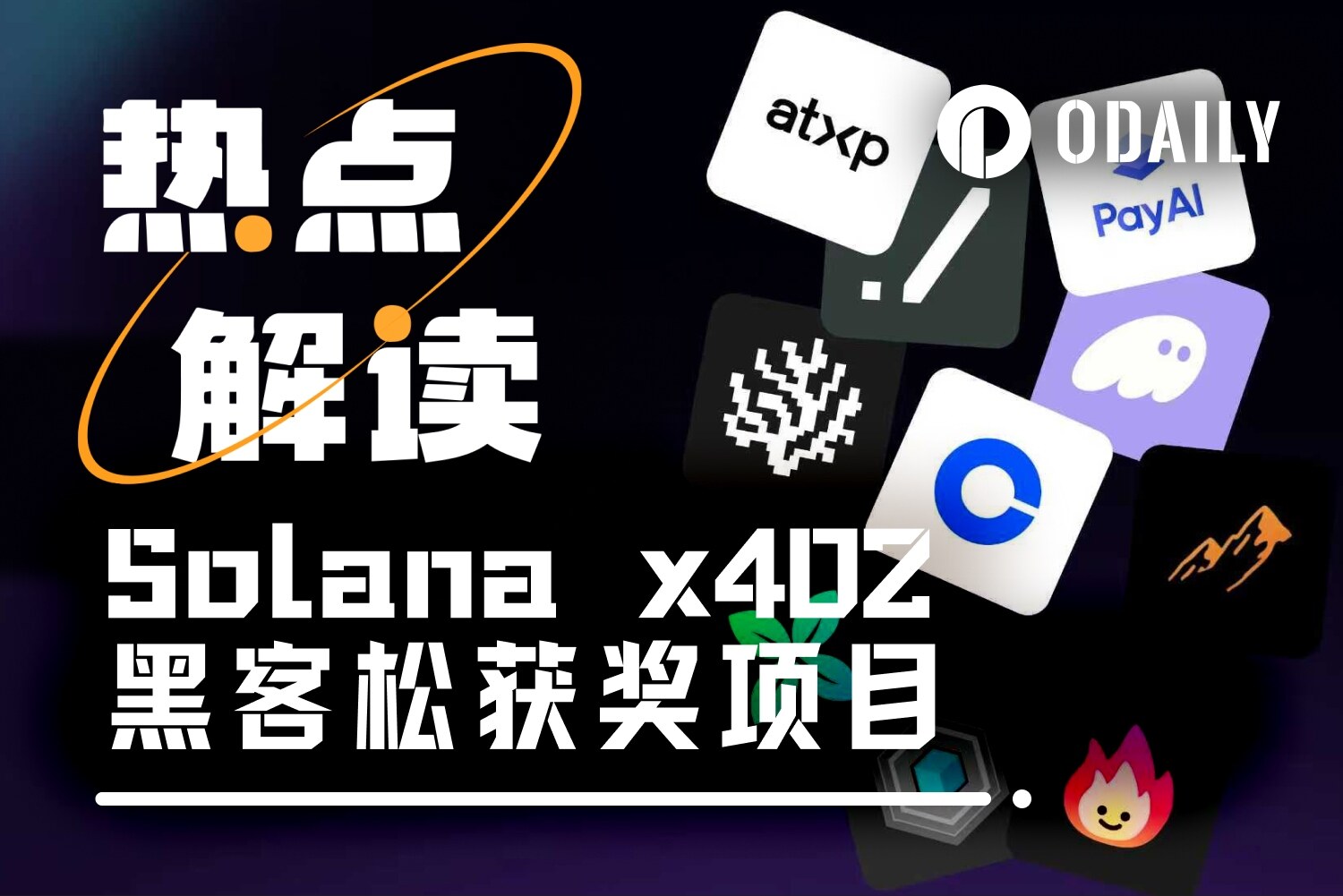Solana x402 Hackathon Concludes: Five Innovative Projects Emerge
Original article | Odaily Planet Daily ( @OdailyChina )
Author|jk
The two-week Solana x402 hackathon concluded successfully in November, with the main track winners officially announced on November 25th. This remote hackathon attracted enthusiastic participation from developers worldwide, ultimately receiving over 400 project submissions. The previously popular AI payment protocol x402, developed by Coinbase, is an internet-native payment protocol. Its goal is to enable AI programs to autonomously complete online payments, much like humans. The vision is for your AI assistant to not only help you find information but also automatically purchase data and subscribe to services—all on the blockchain.
This hackathon featured five competition categories, each with a top prize of $20,000. Let Odaily Planet Daily take you through the innovations of these five winning projects.
Intelligence Cubed (i³): Enabling AI models to trade like stocks
Intelligence Cubed has created a very interesting platform that can be understood as an "AI model version of Taobao + stock market". On this platform, AI models can not only be used, but also bought, sold, and invested in.
Imagine this scenario: You're an AI model developer who has spent a significant amount of time training a powerful image recognition model. In the traditional model, you might need to set up your own servers, handle payments, and manage users. But on the i³ platform, you simply upload your model, set the price per call (e.g., $0.01), and the platform handles everything automatically.
Even more interestingly, i³ introduces the concept of "model tokenization." Developers can sell model ownership in multiple shares through an IMO (Initial Model Offering, similar to an IPO). After investors purchase model tokens, token holders receive a proportional share of the revenue whenever someone uses the model and pays a fee. If someone improves upon your model, your original model automatically receives "royalties." The project also proposes the concept of an "open-source threshold," whereby a model automatically becomes open-source when more than 51% of its ownership is publicly held, accelerating adoption and further creation.
In terms of technical implementation, i³ deeply integrates the x402 payment protocol. Each time a user wants to invoke an AI model, the system first generates a payment request, displaying the amount in USDC required. After the user confirms the payment via their Phantom wallet, the transaction is verified on the Solana blockchain, a process that takes only a few seconds. Only after payment confirmation will the AI model begin working and return results. The platform also provides a visual workflow editor, allowing users to connect multiple AI models like building blocks to create complex processing flows, with the cost of each step clearly displayed.
PlaiPin ( Solana ESP32 Native x402): Enabling IoT Devices to Spend Money Themselves
What PlaiPin does sounds a bit like science fiction: they've enabled a tiny chip (ESP32) that costs just a few dollars to manage its own wallet and make payments. What does this mean?
Imagine you have a smart temperature sensor that collects data daily. In the traditional model, this sensor needs to send the data to a cloud server, and humans decide whether to sell the data. But with this technology, the sensor itself can become an independent "merchant": it can determine when the data is valuable, contact buyers, collect payments, and then deposit the money into its own blockchain wallet.
For example, if your smart refrigerator detects that it needs to access an AI service to optimize its temperature control algorithm, it can automatically pay $0.001 to purchase this service without any human intervention. Or, if your robot vacuum encounters complex terrain while cleaning and needs to purchase an advanced navigation algorithm, it can also complete the payment autonomously.
Technically, the breakthrough of this project lies in packing a complete blockchain wallet and payment capabilities into a tiny chip. The ESP32 chip stores its own private key (like a bank card PIN), which can be used for cryptographic signing to prove "this money is indeed what I'm paying." The entire payment process takes approximately 2-4 seconds: the device detects the need for a paid service, automatically parses the price and receiving address, signs the transaction internally, submits it to the blockchain network through a facilitator (which can be understood as a payment channel), and finally receives the service. Crucially, the user's wallet private key never leaves the chip, ensuring security.
The project code has been tested on real hardware, and the developers have provided detailed installation guidelines. Anyone can purchase a hardware set for a few tens of dollars to try it out. This opens up a completely new business model for IoT devices: enabling devices to become "electronic life forms" that can actively participate in economic activities.
x402 Shopify Commerce: Enable your Taobao store to accept AI customers in 2 minutes
While the previous projects were more technical, the x402 Shopify Commerce project is much more practical. It addresses the question: how can ordinary online stores enable AI-powered customers?
Modern online stores are designed for humans: they have pictures, shopping carts, and checkout buttons. But AI programs "don't understand" these. This project is like installing an "AI-dedicated channel" for online stores: store owners only need to do three things—first, paste their Shopify store's URL and authorization code (30 seconds); second, select which products AI is allowed to purchase (60 seconds); third, open the monitoring panel to view the orders placed by AI (30 seconds). The entire process requires no coding.
Once set up, the AI program can shop like a human. For example, if a company's AI assistant receives a task to "order 100 pens for the office," it will automatically search your store, view the product catalog, select suitable items, calculate the total price, and then pay in USDC. The entire process follows the standard x402 protocol: the AI initiates a purchase request, your store automatically tells the AI "X USDC needs to be paid to this address," the AI completes the transfer, the store automatically creates the order after verifying receipt, and the order will appear in your Shopify backend like a regular order; you simply ship the goods as usual.
This project cleverly combines two open standards: MCP (Model Context Protocol) allows AI to "understand" what products your store has, and x402 standardizes and automates the payment process. More importantly, because it uses direct blockchain transfers, store owners don't need to pay credit card fees (usually 3-5%), and funds arrive in seconds.
For early-stage AI startups, this means they can purchase resources directly from suppliers for their AI products, without human approval or upfront payment. For e-commerce sellers, this opens up a whole new customer base—AI agents who make independent purchases on behalf of companies or individuals.
Amiko Marketplace: Building Credit Profiles for AI
When AI programs start paying for services themselves, a problem arises: How do I know if this AI is reliable? Will it run away after I pay? How good is the quality of the service it provides? Amiko Marketplace is here to solve this problem by creating a "credit profile" for each AI on the blockchain.
The system works ingeniously. Whenever an AI program receives its first payment, the system automatically creates an identity profile for it, recording its wallet address and basic information. Each time the AI completes a task and receives payment, the system creates a permanent record containing information such as who the customer is, how much was paid, and the transaction hash. After using the service, customers can rate the AI (1-5 stars) and leave a review.
The most interesting aspect is its rating mechanism: instead of simply averaging scores, it uses a "weighted average based on payment amount." For example, if an AI receives 5 stars on a $100 transaction and 3 stars on a $10 transaction, its overall rating will be closer to 5 stars because larger transactions have higher weighting. This design prevents score manipulation—it would be very costly and have limited effectiveness for someone trying to generate positive reviews through a large number of small transactions.
For a practical example: You developed an AI translation service, initially with no reviews. A customer spent $50 to use your service, was very satisfied, and gave it 5 stars. Your profile then has the first positive review and a record of "total transaction amount of $50." As more customers use and review your service, your credit score will increase. Other potential customers, seeing that you have over 100 positive reviews and a total transaction amount of $10,000, will naturally be more willing to choose your service.
The system also features a "lazy registration" mechanism: new AI programs don't need to register beforehand; the system automatically creates a profile as soon as someone pays it. This lowers the barrier to entry, allowing any AI program to immediately start providing services and building a reputation. All work records, evaluations, and ratings are permanently stored on the Solana blockchain, which anyone can view and verify, but no one can tamper with.
MoneyMQ: Turn your payment system into a configuration file
The last winning project, MoneyMQ, is a developer tool whose philosophy is that "payment systems should be as simple as writing configuration files."
In Web2, if you want to add payment functionality to your application, you need to: register a payment service provider account, integrate their SDK, write code to handle various payment statuses, set up a test environment, handle refunds and disputes... This process can take weeks or even months. MoneyMQ simplifies all of this to "writing a few lines of YAML configuration file on your laptop".
If you think of YAML as a commodity, or a set of rules for a game, it would look something like this:
Product Name: Advanced API Access
Price: 0.1 USDC
Billing method: Based on the number of calls
Once you've written these rules locally, MoneyMQ will automatically launch a complete payment environment, including product catalogs, billing logic, test accounts, and more. You can simulate the entire payment process on your own computer: initiating a payment request, verifying the x402 protocol, and checking fund arrival. After successful testing, you can deploy it to the production environment with a single click, and all configurations will automatically take effect. MoneyMQ has built-in support for the x402 and MCP protocols. This means that AI programs can not only use your services but also understand your billing rules and even help you optimize your pricing strategy. For example, AI can analyze "how much increase in call volume would occur if the price were lowered from 0.1 USDC to 0.08 USDC" and then suggest price adjustments.
The project's planned "embedded yield" feature is also quite innovative: the balance in your account won't sit idle, but will automatically participate in DeFi (decentralized finance) yield strategies. For example, if you earn 1000 USDC this month, this money will automatically earn an annualized yield of 4-5% before you decide to withdraw it. This is a considerable amount of extra income for companies with large cash flow.
MoneyMQ already provides a Homebrew installer for macOS, which developers can install with a single command.
In conclusion
Of course, these projects are still in their early stages, but the possibilities they demonstrate are already incredibly exciting. For the average user, these technologies may still seem somewhat distant. But imagine this: perhaps in the near future, your smart home system will purchase weather forecasts to decide whether to water the plants, your dashcam will sell traffic data to map companies, and your health monitoring bracelet will pay to use the latest AI diagnostic models… When AI can autonomously handle these small payments, our digital lives may become more intelligent and convenient.
The organizers stated that the winners of the partner track will be announced next week.
- 核心观点:Solana黑客松展示AI与支付融合创新。
- 关键要素:
- i³实现AI模型代币化交易。
- PlaiPin让物联网设备自主支付。
- Shopify项目支持AI自动购物。
- 市场影响:推动AI经济自动化发展。
- 时效性标注:中期影响。



